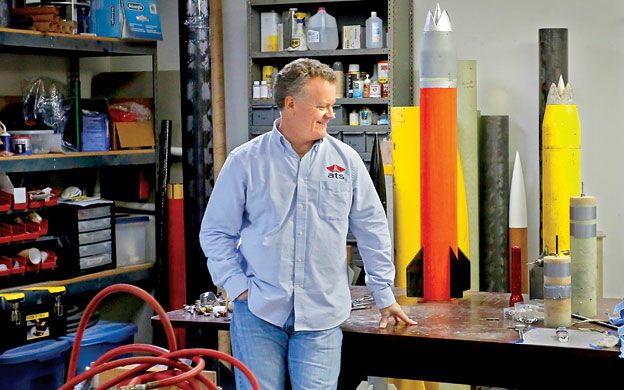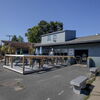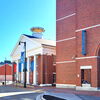Sanford company's rocket research eyes lower-cost space launches
 PHOTo / Tim Greenway
Karl Hoose, president of Applied Thermal Sciences, stands in the test lab and fabrication facility in Sanford where the company builds its rockets.
PHOTo / Tim Greenway
Karl Hoose, president of Applied Thermal Sciences, stands in the test lab and fabrication facility in Sanford where the company builds its rockets.
Space flight is a big idea dominated by big numbers and big corporations. But Karl Hoose, president of Applied Thermal Sciences in Sanford, thinks his company can help bring down the cost of getting into orbit.
“There's a slew of different technologies and businesses that would come from having cheaper access to space, and that's the whole goal for us,” Hoose says.
The price of getting payloads into orbit has dropped substantially in the last decade, but those decreases have come partly by scaling up, not by scaling down. Pushing that trend most prominently is Elon Musk's firm SpaceX, which expects to break a long-sought cost threshold of less than $1,000 per pound of payload with the next iteration of its Falcon 9 rocket, the Falcon Heavy, which the company says could put more than 115,000 pounds into a low Earth orbit.
But in the ATS facility, engineers are working to refine technology that would create the launch vehicle with a 50-pound payload capacity at a cost of $4,500 per pound payload, and in the process serve a niche for smaller, more affordable space vehicles.
Under the hood
To get into a low Earth orbit, a launch vehicle needs to reach around 17,500 mph, roughly 24 times the speed of sound. Typically, that's done with massive rockets carrying tons of fuel and liquid oxygen, which can weigh up to eight times as much as the fuel.
Hoose plans to cut that system out of the equation as much as possible by getting about one minute of propulsion from special jet technology that, at high speeds, runs off of air in the atmosphere, reducing the need for onboard fuel.
With that approach, Hoose projects ATS can deliver a launch vehicle 90% smaller and 85% lighter than a conventional all-rocket propelled vehicle. Such air-breathing engines have been tested at speeds of up to 10 times the speed of sound, but not across the speed range Hoose envisions. He plans to get there through test flights.
“We're going to flight test very cheaply and that will help us optimize before developing the system,” he says.
That approach is evident at the Sanford research facility. A bright orange air-breathing ramjet — a class of jet that runs from Mach 1 to Mach 5 — will be sent up for another test this spring after being recovered and repaired from a previous flight.
This time, the vehicle will aim to travel up to three times the speed of sound, or Mach 3. So far, the company has reached around Mach 1.5 with its second-stage ramjet, launching test flights near the Wyman's of Maine blueberry barrens in Cherryfield. Over four flights, the ramjet engine successfully separated from the rocket that got it just over the sound barrier.
After that, the project faces a number of design challenges to get up to Mach 12, which Hoose estimates will cost around $30 million to engineer. Among those challenges is transitioning through air flow changes from supersonic speeds, up to Mach 5, to hypersonic speeds above and beyond.
Hoose says a unique sawtooth air inlet design, which ATS calls the “King's crown,” will help to widen that range. And, because the vehicle would not carry the potentially dangerous combination of liquid oxygen and fuel storage of a modern rocket, Hoose says it could be launched from more locations than a traditional rocket.
See footage of the company's successful ramjet separation and flight from 2009:
Rick Gaffney, the head of NASA's Hypersonic Airbreathing Propulsion Branch, says such a combined rocket and air-breathing propulsion system “might be achievable” in the next 10 years given constant funding. But he's doubtful about steady financing. Gaffney says funding for development of hypersonic propulsion technology through NASA took a big hit last year. Congress cut funding for hypersonic research by about $13 million, less than the suggested $21 million cut from the Obama administration.
“We've had to respond to that and reduce some of the work we were doing,” Gaffney says.
With that cut, NASA hypersonic flight researchers were directed to collaborate with the Department of Defense in developing air-breathing propulsion technology, in which the department has interest for potential applications in long-range missiles.
“NASA had big goals to reduce the cost of access to space in the past, but that has kind of fallen off and NASA seems to look to private companies and launch providers for that,” Gaffney says. “We're hoping there will be a resurgence, but that doesn't seem to be the case right now.”
Hoose understands well the pivot of looking to the private-sector investment for research and development. In 2011, the end of R&D contracts with the federal government forced the company to cut around a dozen workers, leaving 18 on the payroll. Most of those laid off were engineers working on rocket research and on a lightweight piston engine that's closer to commercialization.
Since, the company's rocket research has been self-funded. In total, Hoose says the company has put around $1.7 million into its testing, adding to a $750,000 grant from the Office of Naval Research and around $50,000 from the Maine Space Grant Consortium. This spring, he expects to hear whether his company won a Small Business Innovation Research program grant through the Navy. But his attention has more recently turned to the private sector. In October, he put together a white paper making the case for his project against others aiming to serve smaller payloads.
“We're not solely focused on federal dollars anymore,” says Hoose.
ATS is not alone in seeking out a market for smaller-scale launches. Virgin Galactic, a recent focus of Virgin Group founder Richard Branson, announced in 2012 its LauncherOne project, a two-stage rocket with a 500-pound payload capacity the company expects to offer to commercial customers in 2016. Boeing is also developing a lighter payload launch vehicle in collaboration with the Department of Defense's advanced research arm.
The ATS project hasn't yet courted any investors, but Hoose says he's working on one potential deal to keep advancing the company's flight testing program. He says his company has done that less expensively, at or below $100,000 a launch, than others in the field. Even then, it won't be cheap.
“Flight-testing is really what's needed,” Hoose says. “... Hundreds to thousands of flight tests will be needed to get one of these things to work.”









Comments